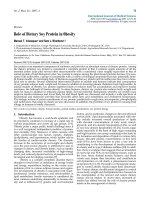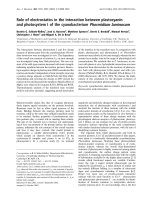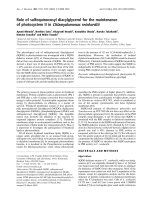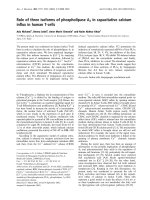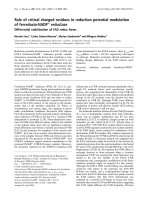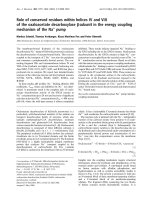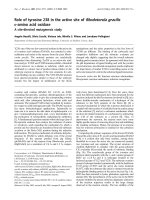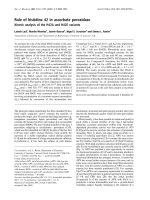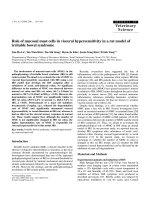Báo cáo y học: "Role of regulatory T cells in experimental arthritis and implications for clinical use" potx
Bạn đang xem bản rút gọn của tài liệu. Xem và tải ngay bản đầy đủ của tài liệu tại đây (46.88 KB, 3 trang )
118
RA = rheumatoid arthritis; T1D = type 1 diabetes; TNF = tumour necrosis factor; Treg = regulatory T cell(s).
Arthritis Research & Therapy June 2005 Vol 7 No 3 Londei
Abstract
CD4
+
CD25
+
T regulatory cells are avidly studied because they
modulate immune responses. Their possible role in autoimmunity
and more specifically in rheumatoid arthritis (RA) has been
highlighted by a string of reports, one of which is in the last issue
of Arthritis Research & Therapy. There are, however, key questions
that have not yet been addressed before their use can be
considered as a real therapeutic option. The first is the actual, in a
clinical setting, efficacy of Treg to treat active chronic autoimmune
diseases such as RA. The second is how we can practically deliver
their therapeutic activity in patients. Once these points have been
addressed we will have a new and potentially very effective ‘magic
bullet’ for the treatment of chronic autoimmune diseases.
In recent years the T-regulatory (CD4
+
CD25
+
Treg) storm
has remodelled the immunology landscape. Since the original
reports of a suppressive activity of CD4
+
CD25
+
Treg, in the
mid-1980s, an exponential number of papers have appeared
in the literature. The employment of CD4
+
CD25
+
Treg for
therapeutic purposes is now one of the ‘holy grails’ in
immunology and much effort is focused on the exploitation of
this therapeutic avenue. In the last issue of Arthritis Research
& Therapy, Frey and colleagues [1] provide an additional
piece to the CD4
+
CD25
+
Treg jigsaw. In most autoimmune
diseases (in humans or in animal models) Treg have been
identified [2,3]. In all tested models these cells were capable
of preventing or partly inhibiting the induction of an
autoimmune response. The absence of Treg, either due to a
Foxp3 genetic defect such as that in patients with IPEX
(immune dysregulation, polyendocrinopathy, enteropathy, X-
linked syndrome) [4] or scurfy mice [5] or by means of
depletion with anti-CD25 monoclonal antibodies in animal
models, favours the initiation of a variety of autoimmune
diseases [3]. Conversely, the adoptive transfer of
CD4
+
CD25
+
T cells prevents the induction of autoimmune
responses [3]. The important role of CD4
+
CD25
+
Treg
during the induction phase of autoimmunity has also been
previously confirmed in collagen-induced arthritis [6], one of
the most widely used RA animal models [7].
Frey and colleagues [1] show that CD4
+
CD25
+
Treg also
have a fundamental role in the experimental antigen-induced
arthritis. However, not all RA animal models seem to respond
to CD4
+
CD25
+
Treg manipulation as described in proteo-
glycan-induced arthritis [8]. On this backdrop the paper by
Frey and colleagues represents only a minor blink of an eye in
the vast Treg literature, but Frey and colleagues introduce a
provocative ‘spin’ to their results as they question the
potential of the ‘therapeutic’ role of Treg on established
autoimmune diseases. In this model, adoptive transfer of
preactivated CD4
+
CD25
+
Treg can prevent the induction of
autoimmunity but cannot ‘cure’ animals with ongoing
autoimmunity. Thus it seems that the thresholds to control
induction or progression (therapeutic action) of an
autoimmune process, by non-antigen-specific CD4
+
CD25
+
T
cells, are significantly different. Frey and colleagues also
monitored the ‘homing’ of the CD4
+
CD25
+
Treg and
detected an accumulation in the inflamed joints, thus
excluding the possibility that the lack of therapeutic activity
was due to the inability of CD4
+
CD25
+
Treg to migrate into
the inflamed tissue. The authors also pointed out that a ‘true’
curative activity of CD4
+
CD25
+
Treg has been reported only
in colitis animal models [9,10], although it could be argued
that experiments in an animal model of type 1 diabetes (T1D)
might also be considered curative [11].
What implications might this study have for autoimmune
diseases, and specifically for RA? A first message is that
when studying CD4
+
CD25
+
Treg we have to bear in mind
the compartment (tissue) that Treg are obtained from. Indeed,
it is apparent that, to gain significant results, studies on
Commentary
Role of regulatory T cells in experimental arthritis and
implications for clinical use
Marco Londei
Institute of Child Health, University College London, London, UK
Corresponding author: Marco Londei,
Published: 7 April 2005 Arthritis Research & Therapy 2005, 7:118-120 (DOI 10.1186/ar1745)
This article is online at />© 2005 BioMed Central Ltd
See related research by Frey et al. in issue 7.2, page 90, />119
Available online />CD4
+
CD25
+
Treg should seek to investigate cells from the
inflamed tissue or the regional lymph nodes. A series of
reports in animal models of autoimmune diseases, such as
T1D [11,12], and also in cancer [13], have clearly demon-
strated this point. This indicates that it might be meaningless
to monitor peripheral levels of CD4
+
CD25
+
Treg. However, in
humans there are obvious restrictions because access to the
inflamed tissues or regional lymph nodes is often
impracticable. The present study also indicates that, despite
the localized accumulation at the site of inflammation,
CD4
+
CD25
+
Treg might not be sufficient to suppress an
ongoing chronic autoimmune inflammatory process.
This idea had already been hinted at by a series of studies in
RA and other chronic autoimmune joint inflammatory
diseases such as juvenile idiopathic arthritis and spondylo-
arthropathies, in which phenotype, distribution and functional
studies of CD4
+
CD25
+
Treg have been performed [14–17].
In all these studies CD4
+
CD25
+
Treg were detected in the
joints or synovial fluid of the patients. In these reports it was
also shown that the identified CD4
+
CD25
+
Treg had a
suppressive function and accumulated in the inflamed joint
[14–17]. One of these studies even reported that
CD4
+
CD25
+
Treg isolated from joints of patients with active
arthritis had a more powerful suppressor activity than
peripheral CD4
+
CD25
+
Treg [17]. Thus, despite the
presence of an increased number of CD4
+
CD25
+
Treg with
a powerful suppressor activity, RA is not suppressed but the
disease is instead very active. The authors provided a
startling explanation for this apparent incongruence, in their
discovery that tissue-infiltrating effector (pathogenic) T cells
were less prone to be ‘suppressed’ by CD4
+
CD25
+
Treg
than resting or naive peripheral blood T lymphocytes [17].
This study therefore suggested that during a chronic
autoimmune inflammatory disease CD4
+
CD25
+
Treg are
attracted to and accumulate where needed but fail to
suppress the autoimmune inflammation. These results
therefore further indicate, in keeping with the paper by Frey
and colleagues, that therapeutic use of CD4
+
CD25 Treg
might not be a feasible option.
However, a recent study has proposed that anti-tumour
necrosis factor (TNF)-α, a benchmark therapy for RA,
drastically influences the function of CD4
+
CD25
+
Treg [18].
The crucial point of that study was that Treg isolated from
patients with active RA before treatment with anti-TNF-α
were unable to suppress proinflammatory cytokine secretion
from activated T cells and monocytes. After anti-TNF-α
treatment the ‘hibernated’ peripheral blood CD4
+
CD25
+
Treg pool recovered and powerfully inhibited, as in healthy
controls, not only T cell proliferation but also the production
of TNF-α and interferon-γ [18]. However, the presence of
functionally efficient peripheral CD4
+
CD25
+
Treg after anti-
TNF-α therapy might be due to a simple redistribution of
these cells, which accumulate in the joints during the active
phase of RA. It is indeed well known that anti-TNF-α
treatment decreases the infiltrate in joints. Furthermore, RA
patients relapse shortly after withdrawal of anti-TNF-α [19]
and thus, despite the dampening of joint inflammation and the
reinstatement of fully functional CD4
+
CD25
+
Treg, RA is still
not cured. These strands of evidence seem to play down a
hypothetical therapeutic role of CD4
+
CD25
+
Treg in RA.
Are there further possible avenues to be explored in the area
of CD4
+
CD25
+
Treg? One possibility is to investigate the
use of antigen-specific CD4
+
CD25
+
Treg. Indeed, it has
been reported that antigen-specific CD4
+
CD25 Treg,
generated and expanded in vitro, might tip the balance and
allow a true curative action in animal models of T1D [12], and
much work is now directed to this area [20]. Two recent
studies in T1D and experimental autoimmune encephalo-
myelitis have highlighted the potential of this option by
genetic manipulation of T cells [21,22]. However, this might
not be an easy road to follow in humans because not all
autoantigen-specific T cells seem to be effective in treating
an ongoing autoimmune disease as described in the T1D
model [22]. Therefore in humans such a prescreening of
effective genetically redirected autoantigen-specific T cells
might be a highly complex task that is not always easy to
achieve. However, in this context, recent studies on RA have
indicated that antigen-specific (HC-gp39) CD4
+
CD25
+
Treg
might be deficient in patients in comparison with controls
[23]. A more recent study indicated that in a restricted group
of RA patients orally challenged with dnaJP1 (a peptide
derived from a bacterial heath shock protein) an increase in
CD4
+
CD25
+
Treg was induced, with evidence of a shift from
a proinflammatory profile to a potentially regulatory one [24].
Although both studies focused on peripheral blood T cells,
they provide encouraging new avenues for novel therapeutic
strategies in RA. Still, more work is required to establish
whether harnessing CD4
+
CD25
+
Treg will represent a viable
therapy for RA and other autoimmune diseases in the future.
Competing interests
The author(s) declare that they have no competing interests.
References
1. Frey O, Petrow PK, Gajda M, Siegmund K, Huehn J, Scheffold A,
Hamann A, Radbruch A, Bräuer R: The role of regulatory T cells
in antigen-induced arthritis: aggravation of arthritis after
depletion and amelioration after transfer of CD4
+
CD25
+
T
cells. Arthritis Res Ther 2005, 7:R291-R301.
2. Baecher-Allan C, Hafler DA: Suppressor T cells in human dis-
eases. J Exp Med 2004, 200:273-276.
3. Fehervari Z, Sakaguchi S: CD4
+
Tregs and immune control. J
Clin Invest 2004, 114:1209-1217.
4. Wildin RS, Ramsdell F, Peake J, Faravelli F, Casanova JL, Buist N,
Levy-Lahad E, Mazzella M, Goulet O, Perroni L, et al.: X-linked
neonatal diabetes mellitus, enteropathy and endocrinopathy
syndrome is the human equivalent of mouse scurfy. Nat
Genet 2001, 27:18-20.
5. Hori S, Nomura T, Sakaguchi S: Control of regulatory T cell
development by the transcription factor Foxp3. Science 2003,
299:1057-1061.
6. Morgan ME, Sutmuller RP, Witteveen HJ, van Duivenvoorde LM,
Zanelli E, Melief CJ, Snijders A, Offringa R, de Vries RR, Toes RE:
CD25
+
cell depletion hastens the onset of severe disease in
collagen-induced arthritis. Arthritis Rheum 2003, 48:1452-1460.
120
Arthritis Research & Therapy June 2005 Vol 7 No 3 Londei
7. Chu CQ, Londei M: Induction of Th2 cytokines and control of
collagen-induced arthritis by nondepleting anti-CD4 Abs. J
Immunol 1996, 157:2685-2689.
8. Bardos T, Czipri M, Vermes C, Finnegan A, Mikecz K, Zhang J:
CD4
+
CD25
+
immunoregulatory T cells may not be involved in
controlling autoimmune arthritis. Arthritis Res Ther 2003, 5:
R106-R113.
9. Mottet C, Uhlig HH, Powrie F: Cutting edge: cure of colitis by
CD4
+
CD25
+
regulatory T cells. J Immunol 2003, 170:3939-
3943.
10. Liu H, Hu B, Xu D, Liew FY: CD4
+
CD25
+
regulatory T cells cure
murine colitis: the role of IL-10, TGF-beta, and CTLA4. J
Immunol 2003, 171:5012-5017.
11. Green EA, Choi Y, Flavell RA: Pancreatic lymph node-derived
CD4
+
CD25
+
Treg cells: highly potent regulators of diabetes
that require TRANCE-RANK signals. Immunity 2002, 16:183-
191.
12. Tang Q, Henriksen KJ, Bi M, Finger EB, Szot G, Ye J, Masteller
EL, McDevitt H, Bonyhadi M, Bluestone JA: In vitro-expanded
antigen-specific regulatory T cells suppress autoimmune dia-
betes. J Exp Med 2004, 199:1455-1465.
13. Curiel TJ, Coukos G, Zou L, Alvarez X, Cheng P, Mottram P,
Evdemon-Hogan M, Conejo-Garcia JR, Zhang L, Burow M, et al.:
Specific recruitment of regulatory T cells in ovarian carcinoma
fosters immune privilege and predicts reduced survival. Nat
Med 2004, 10:942-949.
14. Cao D, Malmstrom V, Baecher-Allan C, Hafler D, Klareskog L,
Trollmo C: Isolation and functional characterization of regula-
tory CD25brightCD4
+
T cells from the target organ of patients
with rheumatoid arthritis. Eur J Immunol 2003, 33:215-223.
15. Cao D, van Vollenhoven R, Klareskog L, Trollmo C, Malmstrom V:
CD25
bright
CD4
+
regulatory T cells are enriched in inflamed
joints of patients with chronic rheumatic disease. Arthritis Res
Ther 2004, 6:R335-R346.
16. de Kleer IM, Wedderburn LR, Taams LS, Patel A, Varsani H, Klein
M, de Jager W, Pugayung G, Giannoni F, Rijkers G, et al.:
CD4
+
CD25
bright
regulatory T cells actively regulate inflamma-
tion in the joints of patients with the remitting form of juvenile
idiopathic arthritis. J Immunol 2004, 172:6435-6443.
17. van Amelsfort JM, Jacobs KM, Bijlsma JW, Lafeber FP, Taams LS:
CD4
+
CD25
+
regulatory T cells in rheumatoid arthritis: differ-
ences in the presence, phenotype, and function between
peripheral blood and synovial fluid. Arthritis Rheum 2004, 50:
2775-2785.
18. Ehrenstein MR, Evans JG, Singh A, Moore S, Warnes G, Isenberg
DA, Mauri C: Compromised function of regulatory T cells in
rheumatoid arthritis and reversal by anti-TNFalpha therapy. J
Exp Med 2004, 200:277-285.
19. Buch MH, Marzo-Ortega H, Bingham SJ, Emery P: Long-term
treatment of rheumatoid arthritis with tumour necrosis factor
alpha blockade: outcome of ceasing and restarting biologi-
cals. Rheumatology (Oxford) 2004, 43:243-244.
20. Bluestone JA, Tang Q: Therapeutic vaccination using
CD4
+
CD25
+
antigen-specific regulatory T cells. Proc Natl Acad
Sci USA 2004, 101(Suppl 2):14622-14626.
21. Mekala DJ, Geiger TL: Immunotherapy of autoimmune
encephalomyelitis with redirected CD4
+
CD25
+
T lymphocytes.
Blood 2005, 105:2090-2092.
22. Jaeckel E, von Boehmer H, Manns MP: Antigen-specific FoxP3-
transduced T-cells can control established type 1 diabetes.
Diabetes 2005, 54:306-310.
23. van Bilsen JH, van Dongen H, Lard LR, van der Voort EI, Elferink
DG, Bakker AM, Miltenburg AM, Huizinga TW, de Vries RR, Toes
RE: Functional regulatory immune responses against human
cartilage glycoprotein-39 in health vs. proinflammatory
responses in rheumatoid arthritis. Proc Natl Acad Sci USA
2004, 101:17180-17185.
24. Prakken BJ, Samodal R, Le TD, Giannoni F, Yung GP, Scavulli J,
Amox D, Roord S, de Kleer I, Bonnin D, et al.: Epitope-specific
immunotherapy induces immune deviation of proinflamma-
tory T cells in rheumatoid arthritis. Proc Natl Acad Sci USA
2004, 101:4228-4233.
